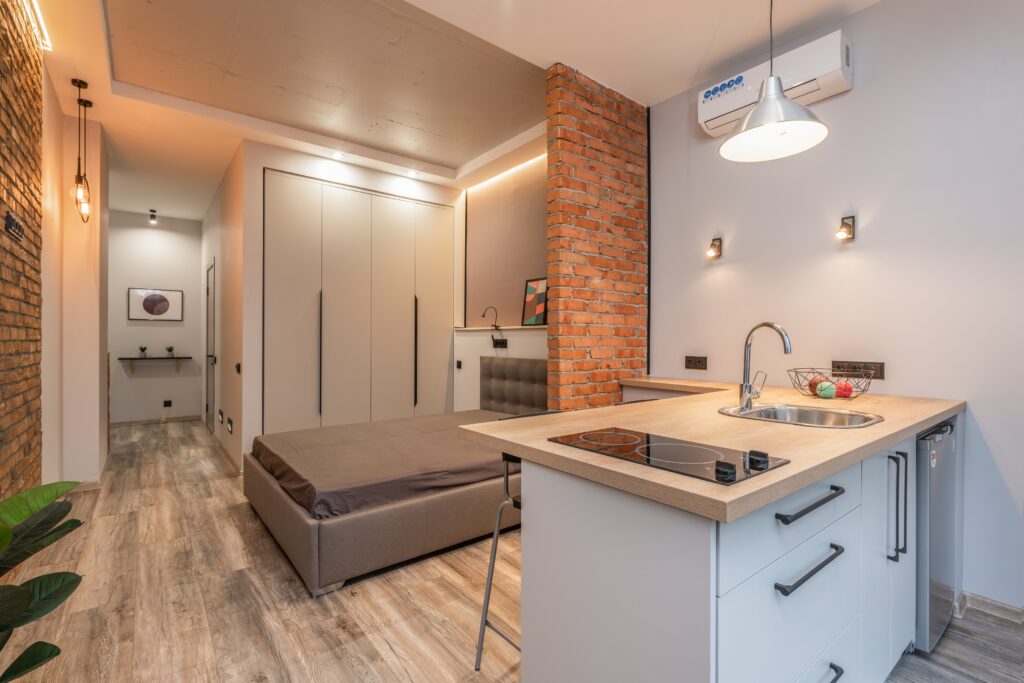In this blog post, we will delve into the world of laminate and vinyl flooring, comparing their advantages, disadvantages, costs, and other essential factors to help you make an informed decision for your home.
When it comes to interior design, flooring plays a crucial role in setting t
he tone and creating a cohesive aesthetic. Among the plethora of flooring options available today, laminate and vinyl stand out as popular choices due to their affordability, versatility, and easy maintenance.
However, when faced with the decision between laminate and vinyl flooring, it’s important to understand their key differences and consider various factors before making a final choice.
Laminate Flooring: Classic Appeal with Exceptional Durability
Laminate flooring is composed of multiple layers, typically featuring a high-density fiberboard (HDF) core, a photographic layer that mimics the appearance of real wood or stone, and a protective wear layer on top. One of the primary advantages of laminate flooring is its remarkable durability.
With its sturdy construction, laminate flooring is highly resistant to scratches, dents, and stains, making it an ideal choice for high-traffic areas in your home. Additionally, laminate offers a wide variety of styles and designs, allowing you to achieve the look of natural hardwood, ceramic tiles, or even exotic materials at a fraction of the cost.

Drawbacks of Laminate Flooring
However, laminate flooring does have its drawbacks. One significant concern is its susceptibility to moisture damage. While laminate manufacturers have made advancements in moisture resistance, excessive exposure to water can still cause swelling or warping of the boards. Therefore, it’s essential to avoid installing laminate in areas prone to moisture, such as bathrooms or basements. Additionally, improper installation can lead to issues with warping and buckling, so it’s crucial to hire a professional or follow installation guidelines carefully.
Cost of Laminate Flooring
In terms of cost, laminate flooring is generally more affordable than hardwood or natural stone options. The average price per square foot for laminate flooring can range from $2 to $5, making it a budget-friendly alternative. However, it’s important to consider installation costs as well, which can vary depending on factors such as the size of the area and the complexity of the installation process.
Vinyl Flooring: Practicality and Style Combined
Vinyl flooring, on the other hand, has gained immense popularity due to its practicality, versatility, and wide range of design options. Composed of several layers, including a vinyl core, a photographic layer, and a wear layer, vinyl flooring provides exceptional resistance to moisture and water damage, making it suitable for areas prone to spills and humidity, such as kitchens and bathrooms. Its waterproof properties also make vinyl flooring an excellent choice for basements or areas where traditional hardwood or laminate flooring may not be suitable.
Styles of Vinyl Flooring
In terms of style, vinyl flooring offers an abundance of options. With advancements in printing technology, vinyl can replicate the look of various materials, including hardwood, stone, and even concrete, with remarkable accuracy. Whether you prefer a rustic oak appearance or a sleek and modern tile design, vinyl flooring has you covered. Additionally, vinyl is relatively softer underfoot compared to laminate, providing a more comfortable and cushioned feel.

Benefits of Vinyl Flooring
While vinyl flooring offers numerous benefits, it does have some limitations. It is not as durable as laminate in high-traffic areas and may be more prone to scratches and dents over time. Additionally, vinyl flooring can fade when exposed to direct sunlight for extended periods. However, with proper care and maintenance, vinyl flooring can retain its appearance and functionality for many years.
Cost of Vinyl Flooring
When it comes to cost, vinyl flooring is generally similar to laminate flooring in terms of affordability. The average price per square foot for vinyl flooring ranges from $2 to $7, depending on factors such as the quality of the material and the design chosen. Similar to laminate, installation costs should also be taken into account.
Comparing Laminate and Vinyl Flooring
To make an informed decision between laminate and vinyl flooring, it’s essential to consider various factors:
- Durability and longevity: Laminate flooring offers exceptional durability and longevity, making it suitable for high-traffic areas. Vinyl flooring, while less durable, provides good resistance to moisture and water damage.
- Resistance to moisture and water damage: Laminate flooring is more susceptible to moisture damage compared to vinyl flooring, which is waterproof and highly resistant to water damage.
- Design and style options: Both laminate and vinyl flooring offer a wide range of design options, allowing you to achieve various looks at an affordable price. Vinyl flooring, however, excels in replicating the appearance of natural materials.
- Maintenance and cleaning requirements: Both laminate and vinyl flooring are relatively easy to maintain and clean. Regular sweeping and occasional damp mopping are usually sufficient to keep them in good condition.
- Installation process and costs: Both laminate and vinyl flooring can be installed as floating floors, which means they are not attached to the subfloor. However, laminate flooring may require additional care during installation to prevent warping. Installation costs can vary, so it’s advisable to seek professional advice or follow manufacturer guidelines.
- Environmental impact and sustainability: Laminate flooring typically contains wood materials, while vinyl flooring is made of synthetic materials. If sustainability is a priority, it’s worth considering the environmental impact of these materials and opting for products with eco-friendly certifications.
- Return on investment (ROI) and resale value: While both laminate and vinyl flooring can enhance the appeal of your home, hardwood flooring tends to have a higher resale value. However, the overall impact on ROI will depend on factors such as the quality of installation, the specific market, and buyer preferences.
The cost of laminate and vinyl flooring
The cost of laminate and vinyl flooring can vary depending on several factors, including the quality of the material, the design chosen, and the size of the area to be covered. Here is a breakdown of the average cost range for laminate and vinyl flooring:
Laminate Flooring:
Average price per square foot: $2 to $5
Installation costs: The installation cost for laminate flooring can vary depending on the complexity of the project and the specific requirements. On average, professional installation can range from $2 to $8 per square foot.
Vinyl Flooring:
Average price per square foot: $2 to $7
Installation costs: Similar to laminate flooring, the installation cost for vinyl flooring can vary based on factors such as the size and complexity of the project. On average, professional installation can range from $1 to $4 per square foot.
It’s important to note that these cost ranges are approximate and can vary depending on your location and the specific products and services you choose. It’s recommended to obtain quotes from multiple suppliers and installers to get a better understanding of the overall cost for your project.
Additionally, when considering the cost, it’s essential to factor in any additional materials or accessories required for the installation, such as underlayment, adhesive, trim, and transitions. These items can contribute to the overall cost of the flooring project.
Lastly, while laminate and vinyl flooring offer budget-friendly options compared to materials like hardwood or natural stone, it’s important to prioritize quality and durability when making your decision. Investing in higher-quality products and professional installation can ensure better longevity and performance, ultimately saving you money in the long run.
FAQs Section
: The main difference lies in their composition. Laminate flooring is made of multiple layers, including a high-density fiberboard (HDF) core and a photographic layer that mimics the appearance of natural materials. Vinyl flooring, on the other hand, consists of layers of vinyl, with a photographic layer and a wear layer on top.
In terms of durability, laminate flooring tends to be more resilient to scratches, dents, and stains compared to vinyl flooring. Laminate is a good choice for high-traffic areas. However, vinyl flooring offers better resistance to moisture and water damage, making it suitable for areas prone to spills or humidity.
While both laminate and vinyl flooring can be installed in bathrooms or basements, it’s important to consider their resistance to moisture. Vinyl flooring is waterproof and highly resistant to water damage, making it a better choice for these areas. Laminate flooring, although more water-resistant than before, is still susceptible to moisture damage and may not be the best option for bathrooms or basements.
Both laminate and vinyl flooring offer a wide range of design options. Laminate flooring can replicate the look of natural hardwood, stone, or tile with various finishes and textures. Vinyl flooring, however, excels in mimicking the appearance of different materials, including wood, stone, and even concrete. It offers more versatility in terms of design and can create a highly realistic and diverse range of styles.
Both laminate and vinyl flooring are relatively easy to maintain. Regular sweeping or vacuuming, along with occasional damp mopping, is typically sufficient to keep them clean. However, vinyl flooring requires less maintenance when it comes to water resistance, as it is inherently waterproof. Laminate flooring should be protected from excessive water exposure to prevent damage.
Laminate flooring typically contains wood materials, which may not be as environmentally friendly as vinyl flooring made of synthetic materials. However, there are eco-friendly laminate options available that use sustainable or recycled materials. Similarly, some vinyl flooring manufacturers offer products with eco-friendly certifications. It’s important to check for sustainability labels or certifications when considering the environmental impact of these flooring options.
Final words of advice or tips for flooring selection between laminate and vinyl flooring
Choosing between laminate and vinyl flooring depends on several factors, including your budget, the location and usage of the room, your design preferences, and your lifestyle and maintenance needs. If moisture resistance is crucial and you desire a wide range of design options, vinyl flooring may be the better choice. On the other hand, if durability and longevity are a priority, and you prefer the look of natural materials, laminate flooring may be the right fit for you. It’s always beneficial to seek professional advice or consult with flooring experts to ensure you make the best decision for your specific needs.
In conclusion, laminate and vinyl flooring offer practical and cost-effective options for homeowners seeking durability, style, and easy maintenance. By understanding the advantages, disadvantages, costs, and other factors associated with each type, you can confidently choose the flooring that aligns with your preferences and requirements. Whether you opt for the classic appeal of laminate or the practicality and versatility of vinyl, both options have the potential to transform your space and create a beautiful foundation for your home’s interior design.





